|
Index...
|
I am grateful to Kathy Hahn, who discovered Mrs. Binns through the St. Joseph's Convent 'Mystery' page on this website, for which Catherine had kindly written offering to help if she could. Kathy exchanged many e-mails with Mrs. Binns, who kindly shared her memoirs with her. Mrs. Binns was a day-girl with the school in Coventry, then became a boarder after the school had been evacuated. When the senior school moved to Offchurch House in 1941 she and her sister went there while their younger sister stayed at the Abbey.
These letters contain her memoirs of the war years and her time with of St Joseph's, and many of them of in response to the questions that Mrs. Binns always kindly helped with. It's these letters that the following page is from.
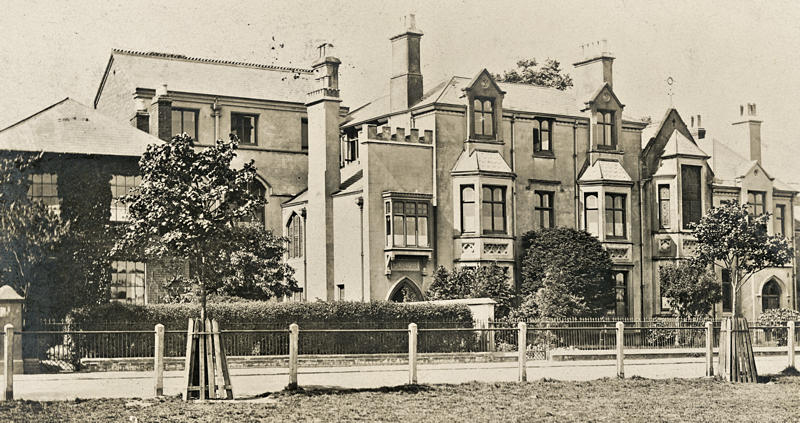
 was at Stoneleigh Abbey during the War. St Joseph's Convent, Coventry was evacuated there and I went too, though for a while I went daily from my home in Coventry. This proved a problem as it meant two buses and a long walk down the long drive and back again, so I became a boarder. We were given the basement area, the next floor up and the top floor, and changed use over the time. The basement was the dining room, though for a while we used the Monk's old refectory which meant a walk through the cloister area and across the courtyard... not ideal especially in bad weather. The floor above, which is the area now shown to visitors at the Abbey, was two dormitories, I can't recall how many slept in each room but we were in camp beds in rows. The rooms were oak panelled and with large paintings on the walls and large windows with heavy shutters that had to be closed every night, black out. I was in the room on the corner which had four huge windows.
was at Stoneleigh Abbey during the War. St Joseph's Convent, Coventry was evacuated there and I went too, though for a while I went daily from my home in Coventry. This proved a problem as it meant two buses and a long walk down the long drive and back again, so I became a boarder. We were given the basement area, the next floor up and the top floor, and changed use over the time. The basement was the dining room, though for a while we used the Monk's old refectory which meant a walk through the cloister area and across the courtyard... not ideal especially in bad weather. The floor above, which is the area now shown to visitors at the Abbey, was two dormitories, I can't recall how many slept in each room but we were in camp beds in rows. The rooms were oak panelled and with large paintings on the walls and large windows with heavy shutters that had to be closed every night, black out. I was in the room on the corner which had four huge windows.
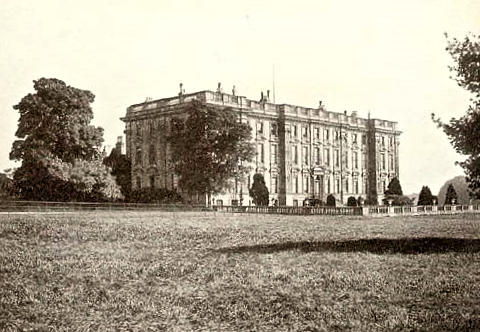
Later I read that Jane Austin, who was related to the Leighs, visited there, and said the view from that room was the best in England. Now it is called Queen Victoria's bedroom and has one large bed where there were so many! At the time I didn't know this and remember being taken once to a room above and told that was where she slept and shown a small bath in a cupboard which was put in for her? I have many more stories of time there but thought you'd better read a little first. Luckily I have a very good memory at 86!
To get back in time... life at Stoneleigh was hard in many ways for the girls. Firstly, we were away from our families who were living in a city of factories which were attractive to German bombers... the factories had made cars and bicycles but changed to munitions etc. during the war. I expect you have heard about the Coventry Blitz? It became well known, although we met a young man in upstate New York who thought only London was bombed! I was at Stoneleigh that night, November 14th 1940. The nuns had heard the bombers flying over and suspected they were heading for Coventry so spent the night praying in the chapel. The girls heard about it the next day and, as we all had family there, it was a worrying time. Gradually over the day news came, but I and two other girls had heard nothing. Lord Leigh said he would drive over with our addresses to see what he could find; that was two days later. There was no post or telephone connections and the city was under military control. However, I was looking from a window on the top floor and saw my father cycling down the drive! My family were all OK, my parents, sisters, grandmother and aunt... and by a miracle not one girl at the Abbey lost anyone. The Convent in Coventry was bombed, however, which is why after the war the nuns had to find somewhere else to live and bought an old house near Kenilworth.
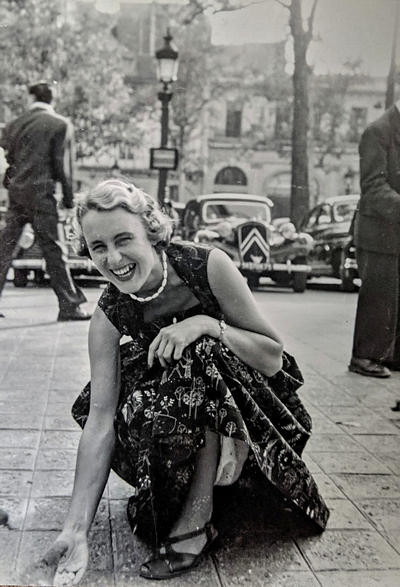
I am afraid the story about a German bomber machine gunning the students is not true! It was sent to me, and I don't know who the girl was who wrote it, but I can give the true story as I was there during the incident. That lunch time I went for a walk over a ploughed field away from the Abbey... she is still alive and living in South Africa and I am still in touch with her. As we walked we heard the sound of machine gunning and, turning, saw a German bomber being chased and machine gunned by three or four Spitfires. We ran and got behind a large oak tree, and whilst my friend was in hysterics I watched as they flew overhead and over the next field. I then saw black objects dropping from the bomber and I grabbed my friend and we ran back towards the Abbey drive. I don't remember hearing any explosion but as the field had recently been ploughed they would have landed in soft ground. In my opinion it had been a decent German as he had turned away from the Abbey and didn't drop the bombs until he was clear of buildings, not one who would have turned towards the Abbey to machine gun children! I wrote to the paper and corrected it but heard no more. I also recently tried to find any news of the story, re. the bombs etc., but nothing to be found. However, a lot of things were kept quiet at that time. I kept a diary from 1941 so I was able to check the date it happened as I'd written about it at the time in my Schoolgirl's Diary! When I tell these stories to my American friends they say I should publish them; in fact one of them has kept them all.
I am afraid I can't tell you when the other two girls got information about their family after the Blitz, but I do know that no one there lost anyone in Coventry that night. My two younger sisters had been evacuated elsewhere but were brought back to Coventry, and after the Blitz there are other younger children who were taken in at Stoneleigh, including the new friend I found. I was in Coventry during another raid however, in the following April. We had gone home for the day but I wasn't well, so stayed back and that night the German's bombed Coventry again, twice during that week. Apart from broken glass in every window of our house and a crack which later had to be filled in we survived. Sadly, that night I was there, two sisters who had been at Primary School with me, plus their Mother, were in a shelter in their garden and it got a direct hit so both were killed; a terrible shock for their father who had been out working in the city centre and came back, saw the house was OK, but then found the three bodies in the back garden.
Every week a group of friends meet for coffee and chinwag at each other's homes. At the one this morning I talked with the friend who was at Stoneleigh Abbey and who I found online. We don't remember each other as she is a few years younger than me, but I mentioned the article written about Stoneleigh Abbey as it was her husband who found it and forwarded it to me. We both agree some of the things mentioned don't ring true with us, as well as the machine gunning story, which I could correct. We were doubtful about the story of the hay filled mattresses. Although I didn't board at first, by the time I was we all had wooden camp beds... I think she made up some of it.
 remember how cold it was in the Abbey; we all got chilblains on our toes and fingers! The food was pretty grim, but some of that could be excused as there was rationing. We had to give the nuns our ration books, so if we went home our parents had to share their rations. I often tell younger people the story of "true friendship"! We were rationed to one egg each a week, but my parents and my friend's parents kept hens in the back garden, as many people did during the war. We both took three eggs each from home when we went on a Sunday and wrote a day from Monday to Saturday on them... we got our ration egg on a Sunday but we had an egg every day between us alternating days. For example, I would have a whole boiled egg Monday, Wednesday and Friday and she would have the other days but we gave each other the top of our egg... true friendship! When I was teaching little ones they were fascinated by this story.
remember how cold it was in the Abbey; we all got chilblains on our toes and fingers! The food was pretty grim, but some of that could be excused as there was rationing. We had to give the nuns our ration books, so if we went home our parents had to share their rations. I often tell younger people the story of "true friendship"! We were rationed to one egg each a week, but my parents and my friend's parents kept hens in the back garden, as many people did during the war. We both took three eggs each from home when we went on a Sunday and wrote a day from Monday to Saturday on them... we got our ration egg on a Sunday but we had an egg every day between us alternating days. For example, I would have a whole boiled egg Monday, Wednesday and Friday and she would have the other days but we gave each other the top of our egg... true friendship! When I was teaching little ones they were fascinated by this story.
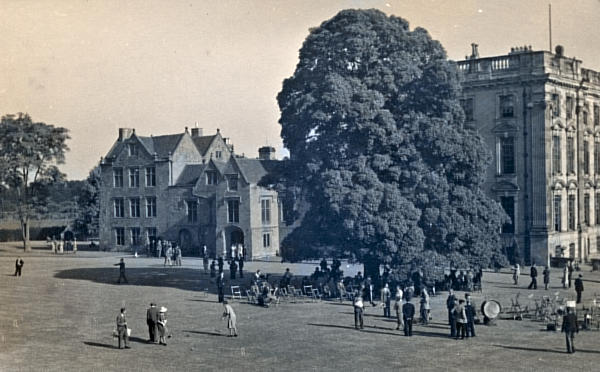
When we were sleeping in the two huge rooms at Stoneleigh Abbey we were woken early in the morning, then it was a rush down a flight of stairs to the basement, then up along a corridor and up another flight of stairs to the top floor where the bathrooms were! After washing etc. it was repeat journey back to the dorm! Once I had been so worried I dreamt about it and woke to find I had got dressed in my sleep! If you needed a toilet in the night that was another problem, especially for those in the furthest room... it was completely dark so you could see nothing but had to feel the way out of the one room and across the other, both full of beds with sleeping girls. Then you crossed an area at the back of the chapel organ balcony to the one toilet... and repeat back. Strange things happened on that journey, but one I recall is as I passed one bed the occupant sat up, still asleep, and said "I have three houses on the Strand!"... this referred to the game of Monopoly which was very popular at the time.
I don't think it ever got easier finding the way in the dark; remember, they were big rooms with many rows of camp beds and nothing else. Had it been a smaller room with more differing furniture it might have been easier.
Walking in your sleep was also quite common as we were disturbed youngsters. One incident I remember is, I was dreaming I was at home and the siren had sounded. When this happened I would grab a pillow and go and wake my parents and sisters; the dog and I always seemed to hear the siren before anyone else, in fact I felt I heard or sensed it before it actually went, and so did the dog! In the dream I was banging on my parents' bedroom door but in fact I had walked in my sleep to the other side of the room and was banging on the bed of another girl, who happened to be Italian, and we both woke with a start! Incidentally, her Father and older brothers were interned on the Isle of Man.
We would put on shows and the headmistress was a very talented lady, she would write songs for us to sing, she would make words to a popular folk song and I can still remember most of the words.
My father moved to Coventry from Liverpool in the 1920s for work with a brother and a cousin. When he married my mother, who was from Southport, a seaside resort north of Liverpool, they bought a house in Coventry and my sisters and I were born and went to school in the area. However, both my parents wanted to get back north so they moved to Wirral soon after the War ended. It was a hard time as rationing was still on and many things were lacking... it was sad that here we suffered after the War when other countries got help, even though we had won?
Incidentally, the older girls left Stoneleigh Abbey and moved to a lovely house in a village near Leamington, whilst the younger ones stayed at Stoneleigh until the nuns bought a bigger house in Kenilworth which became St Joseph's Convent. It is no more, sadly, and the house itself was pulled down.
I went to Offchurch with the older students, and so did my sister who is 18 months younger than me, but our younger sister stayed at the Abbey then went to Crackley Hall. The house in Offchurch was a lovely building with gardens in a village. In the old church opposite the house there was an old stone coffin which was said to be Offa, King of Mercia, hence the name Offa's church, Offchurch.
I went back to Stoneleigh twice many years later, when the public were admitted, but just into the floor with the lovely rooms I mentioned. The second time I went most of the Abbey had been turned into luxury flats. Lord Leigh had sold the Abbey. He was the son of the Lord Leigh who was there in the War and had been one of the two boys we occasionally saw at the time, as Lord and Lady lived in the old Abbey part. I only heard about that Lord Leigh, that he married three times and had to sell and move out.
I think the house in Offchurch wasn't big enough to take all the children which is why only the older ones went there, three classes if I remember correctly. As it was more like a normal house the dormitories were small and only held about five girls. There, too, I was in a room on the corner, I've only just realised that! There were two bathrooms just at the other side of the corridor, which was bliss after the Abbey. By the time the house was bought in Kenilworth I had left, as had most of the girls at Offchurch, so it became just for the nuns. I have a cousin who by chance lives in the village of Offchurch, and we have stayed with her several times, so I have followed what happened there. The house was sold but I visited there with my husband and son. He was a little boy at the time, and we met two nuns I had known.
The room next to the one I slept in at the Abbey was also a dormitory, the one I had to go through to get out. The Saloon was not used except for very special occasions like giving a concert, but I remember how beautiful it was and I loved a painting of a lady, probably a Lady Leigh, standing on some steps with a small dog in her arms. I have a memory of white and gold. Although the Queen Victoria room is now painted in white and pale blue, the wood panels in both rooms were not painted when we were there... it says in the booklets it was painted for Queen Victoria but it certainly wasn't when we were there.
The classrooms were on the top floor, and later the dormitories were moved up there too, though not for long in my memory.
When I visited the Abbey, twice, some years ago we entered by the lovely main entrance at the side, but we never used that entrance when we lived there, we used the entrance facing the Gatehouse. With the guide we went to the room which we used as a dining room and she said that was where the convent girls slept. I corrected her each time but it seemed she kept to that story.
I remembered that the last time I visited Offchurch the house had been bought by people who were using the stables and running a riding school. The stables were at the back of the house and during the time we were there were used as classrooms.
 have my son visiting this weekend so have been busy. Unfortunately, today we have had rain and gale force winds so we just went to a pub for lunch and I am cooking pork ribs for dinner this evening. Tomorrow the weather is forecast to improve so he will take us for a drive round the lovely countryside and we will have lunch again in a pub.
have my son visiting this weekend so have been busy. Unfortunately, today we have had rain and gale force winds so we just went to a pub for lunch and I am cooking pork ribs for dinner this evening. Tomorrow the weather is forecast to improve so he will take us for a drive round the lovely countryside and we will have lunch again in a pub.
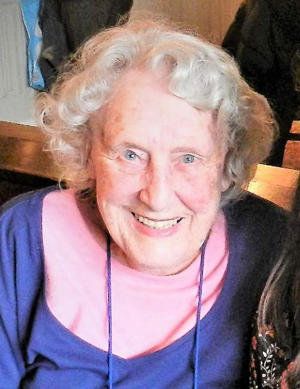
To go back to Stoneleigh, the entrance we went in by took us into the basement area, a cold dark place which had the large room we used as a dining room and the entrance to the lower part of the chapel. There was another room which was used at first as an emergency dormitory for the little ones who came after the blitz. There were glass cases all around the walls with stuffed animals and birds, which scared my little sister! This floor was on the level with the old cloisters, etc.
I did correct the guide on my first visit, saying we didn't sleep in the room she said we did, but which was our dining room, and also that we were told a different room was the one Queen Victoria slept in, but on the second visit she hadn't corrected it! Incidentally, that room, now called QV bedroom, has another mention; Jane Austin, who stayed there with her mother who was related to the Leighs, did you know that? She said the view from that room was the best in England. I don't think she and her mother were treated very well, and her book Mansfield Park is said to tell that. Her Mother wrote a lot about their time in Stoneleigh, did you know? You can find it online.
You ask what we did during our free time at Stoneleigh Abbey... there were tennis courts that the sporty girls used, or we would go for walks along the drives which went both ways with wooded areas. We didn't go near the river. I don't think we were allowed to do so as it was thought too dangerous. Indoors we had games like Monopoly which was very popular... and we would take a slice of bread and marg after supper and try to toast it on the open fire in the dormitory! It wasn't very successful and we called it "Jimmy Frizzle". Living in such a large building, getting to and from rooms took a lot of our time, too. We sang a lot, in the chapel etc. and especially songs Sister Frances wrote to old tunes. I remember when we did concerts for various reason she did this. When the Rev. Mother was celebrating her golden jubilee we had a celebration and there was a song to the Lincolnshire poacher tune. Some girls (one was me) held letters spelling "Happy Jubilee" and sang a verse in order. I can remember some of those words still! When my friend who lives in South Africa visits me we see how many we can remember... they were very clever and funny. Another concert was when the Bishop of Birmingham visited us... he was a cousin of sister Frances. I also knew him for many years as his twin brother was our parish priest. We sang a special song for him which ended each verse "A Cardinal's cap in the morning!" and soon after he was made Cardinal of England and moved to London. He was Bernard Griffin and I have his autograph in my album! Sadly he died young, he was a very nice man.
The nuns were divided, some taught and others did house work. We were taught mostly by nuns, mainly because Stoneleigh was quite a distance for teachers to come, but we did have some who lived with us but they came and went. It was a difficult time for children's education as many teachers went into the forces, so we mainly got older teachers... some who had retired and often not very good! In my final year at Offchurch when I was taking my School Certificate, Sister Frances took over teaching us every subject, but we didn't do any science subjects nor maths finally. Children who were educated during the War really did so against the odds!
I am pleased to hear praise of children brought up during the war... we are now getting few and soon will be all gone, and perhaps we will be forgotten. However people like you might keep our memory alive?
Incidentally, you mentioned the school that was at Castle Howard, did you know they were from Scarborough?
The nuns never discovered our secret dorm feasts, luckily.
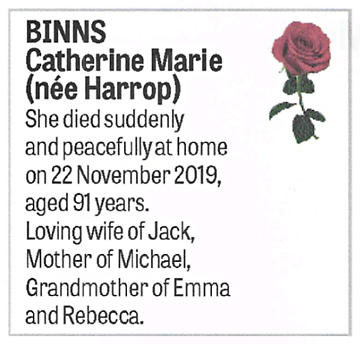
I can't remember Rev. Mother's name. We liked to try to find what their names were before they became nuns. It wasn't easy finding a nun's previous name so we didn't manage to find many. Another trick we had was to see if we could remove the pin that the nuns used to keep their veils back; we collected them as they had a coloured end and these things were hard to buy at the time.
I first met Bernard Griffin when I was a little girl and he was a young priest at a party at Harbourne Hall, an orphanage near Birmingham. I recently read that there had been sex scandals there later. I remember it as a lovely old house where I went as a Brownie, pre Girl Guide.
We didn't have Girl Guides at the Convent but I had been a Brownie before the War and was just starting as a Guide. In fact I joined the Brownies when I was officially too young so they called me a Tweenie until I reached the right age. It is strange that I still seem to live by the song about the group I became leader of, the Elves! We sang "Here we are, the little elves, helping others, not ourselves!"
My friends are amused at my memory for poems, as I often start saying one when something reminds me. One friend says "Have you a poem for everything??"
We knew very little about the Leigh Family, even though they also lived at the Abbey, as they lived in a different part, the medieval part where we never went. We would go through the old cloisters which were underneath that part to get to the monks' dining building in what was left of the original old abbey. As I said we occasionally saw the boys outside but I only remember Lord Leigh when he came to help after the Blitz.
Please try this link to see more photographs of the girls at St. Joseph's Convent.
This is your first visit to my website today, thank you!
3,157,260Website by Rob Orland © 2002 to 2024